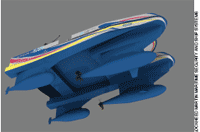Rethinking Rig Embarkation
The market for a safer ship embarkation system is growing as drilling rigs move farther offshore.
- By Jerry Laws
- Mar 01, 2008
 Work on an offshore oil or gas rig presents
many hazards. Getting out
there can be dangerous, too, because of
sea and weather conditions. Helicopter
transport has a good safety record, but
even the United Kingdom Offshore Oil
and Gas Industry Association Ltd, which
claims to be the world leader in offshore
helicopter safety, has experienced two
fatal crashes, with 18 deaths, in the past
decade. Worldwide in 1995-2005 (the
latest period for which worldwide comparisons
are possible), there were 63 fatal
accidents around the world during offshore
helicopter transport, which annually
moves millions of passengers back and
forth. More than 56 million were flown
from 1997 to end of 2006 in the UK Continental
Shelf region alone. These statistics
come from the association’s “UK Offshore
Public Transport Helicopter Safety
Record 1977-2006,” which calculated this
region had an occupant fatal accident rate
of 1.39 per 100,000 flying hours when
considering the helicopter types now in
use and a non-fatal reportable accident
rate of 1.55 per 100,000 flying hours.
Work on an offshore oil or gas rig presents
many hazards. Getting out
there can be dangerous, too, because of
sea and weather conditions. Helicopter
transport has a good safety record, but
even the United Kingdom Offshore Oil
and Gas Industry Association Ltd, which
claims to be the world leader in offshore
helicopter safety, has experienced two
fatal crashes, with 18 deaths, in the past
decade. Worldwide in 1995-2005 (the
latest period for which worldwide comparisons
are possible), there were 63 fatal
accidents around the world during offshore
helicopter transport, which annually
moves millions of passengers back and
forth. More than 56 million were flown
from 1997 to end of 2006 in the UK Continental
Shelf region alone. These statistics
come from the association’s “UK Offshore
Public Transport Helicopter Safety
Record 1977-2006,” which calculated this
region had an occupant fatal accident rate
of 1.39 per 100,000 flying hours when
considering the helicopter types now in
use and a non-fatal reportable accident
rate of 1.55 per 100,000 flying hours.
Helicopter transfer is expensive, their
airspace is becoming crowded, and deepwater
rigs are working farther and farther
from shore in some parts of the
world, said Larry Denton, who works on
crew transfer as the business development
manager, Ship Systems for Lockheed
Martin’s Maritime Security and
Ship Systems line of business, which is
based in Baltimore.
The alternative to helicopters is
moving workers by ship, which presents
hazards of its own when workers are lifted
and lowered by crane in baskets between a
rig and a ship’s deck. Lifting and hoisting
operations of all types—not just crew
transfers—are one of the leading causes of
deaths and serious incidents in global
exploration and production activities,
according to the International Association
of Oil & Gas Producers (OGP), whose
Safety Committee’s Task Force on Lifting
and Hoisting developed a Recommended
Practice document to focus the industry
on safe lifting. (The document lists three
essential principles for lifting personnel:
Avoid it “unless the risk has been demonstrated
as being as low as is reasonably
practicable,” lift according to a specific
personnel lift plan for that lift, and properly
secure lifted personnel with lanyards
“unless written procedures and risk assessment
require otherwise.”)
High Lifts and High Seas
The vertical lifts range from 40 feet to
more than 100, said Denton. “Generally,
you’re talking about transferring people in
significant sea states, so you’ve got a vessel
that’s moving around quite a bit in the
water,” he said. “There’s limited safety for
the person as they’re in the basket and
being lifted to the rig.
“You start to get a pendulum effect,
where if the crane isn’t directly above the
basket, the basket starts to move quite
significantly as it’s raised to the crane.
Some of the most significant injuries
occur during that lifting process, where
people either fall into the water or, due to
the pendulum effect, they hit the rig. On
the other hand, you have people hurting
their backs and necks when you’re setting
that down on the rig, because obviously,
in significant weather, it’s not always a
nice landing.
“The ship’s performance capabilities
are a huge component of the safety
because the ship’s ability to remain in
close proximity to the rig during the
transfer and to limit the motions of the
ship during the transfer are huge,” he said.
A new ship design and a new type of
transfer interface are Lockheed Martin’s
contributions to a comprehensive transfer
system launched recently with VIKING
Life-Saving Equipment Norge AS.
VIKING’s portion is Selstair, a collapsible
staircase with non-slip aluminum
steps and landings, handrails, and a safety
net around the staircase. This embarkation
system will work in any weather and
offers significant cost advantages over
helicopter transport, the companies say.
The patented SLICE® vessel design
has four submerged pods. This decreases
the vessel’s surface area, lessening the
impact of water movement on it and giving
SLICE “phenomenal seakeeping ability”
while under way and while stationary to
transfer, Denton said. As for the third
component, Lily Birmingham, a Lockheed
Martin engineer on the project, described
the CEway crew transfer system as a
unique interface riding on rails. It allows
rotational freedom and will slide on the
boat to accommodate some of the travel
motion, she said.
The market for this solution is growing
as drilling moves farther offshore in West
Africa, Southeast Asia, and the North Sea.
“There are many areas of the world where
you’re talking significant sea states, high
winds, and pretty good distances from
shore that would feed right into this type
of transfer system,” said Denton.
This article originally appeared in the March 2008 issue of Occupational Health & Safety.